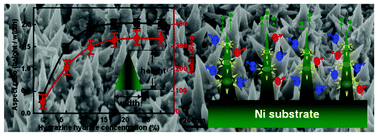We present the fabrication of Ni nanocone arrays on Ni foil substrate as well as gas exposure field electron emission experiments using them as cold electron cathodes. The self-assembly of nanoscale building blocks into organized conical superstructures is achieved by the assistance of oriented attachment. These Ni nanocones grow only along the [111] direction and to be controlled mainly rely on two factors: the surface energies and the lattice matching extent of the attached surfaces. On the basis of the equilibrium between nucleation rate and crystallization rate, Ni nanocones with different aspect ratio (0.2–2.2) are prepared by adjusting the concentration of hydrazine hydrate and growth temperature. Field electron emission measurements indicate that the as-grown Ni nanocone array is an excellent field emitter exhibiting low turn-on field, high current density, and large field enhancement factor due to sharper tips and better contact with the Ni substrate. Meanwhile, we find that adsorbed gas molecules greatly hindered the field electron emission performance of the Ni nanocone array, and oxygen and nitrogen gases show different suppressive behaviors, which strongly correlate with the electronegativity of the individual species. Repeated applying voltage or ‘vacuum J–E annealing’ could significantly improve field emission properties and stability, which is attributed to desorption of the adsorbed gas molecules through Joule heating.

You have access to this article
 Please wait while we load your content...
Something went wrong. Try again?
Please wait while we load your content...
Something went wrong. Try again?


 Please wait while we load your content...
Please wait while we load your content...